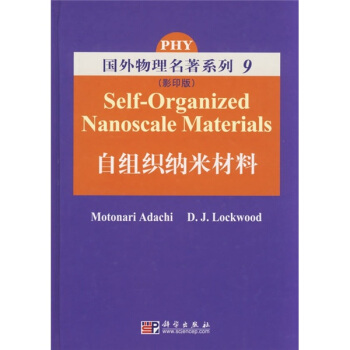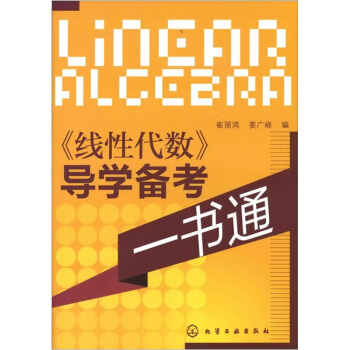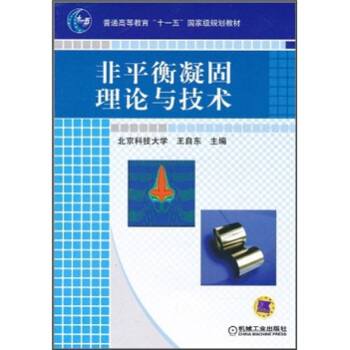

具体描述
内容简介
《自组织纳米材料(影印版)》包含了大量通过化学、仿生学途径并运用自组织机制合成纳米材料并产生不同尺度的组件的方法。过去的几十年里。纳米结构新颖的系统性能在自然科学的各个领域中得到广泛认可,新技术的不断发展吸引了各个领域的科学家投入到与之相关的研究中。要全面实现纳米科学与技术的巨大应用前景,面临的重要挑战就是寻找在原子尺度上调制排列结构的方法以及构造原子、介观、宏观各尺度层次的材料。《自组织纳米材料(影印版)》介绍了纳米结构自组装领域从基础理论到相关应用的大量令人鼓舞的最新进展,可供物理学、化学、生物学、工程和材料科学领域中科研人员和研究生参考。目录
Preface1、Self-Assembled Si1-xGex Dots and Islands
Jean-Marc Baribeau,Nelson L.Rowell,and David J.Lockwood
1.1 Introduction
1.2 Si1-xGex Island Growth
1.2.1 Growth Modes in Heteroepitaxy
1.2.2 Si1-xGex Island Growth and Shape Evolution
1.2.3 Si1-xGex Island Composition and Strain Distribution
1.3 Stacked Si1-xGex Islands
1.3.1 Development of Morphological Instabilities in Heteroepitaxy
1.3.2 Synthesis,Structure,and Vertical Correlation
1.3.3 Vibrational Properties
1.3.4 Optical Properties
1.4 Engineering of Si1-xGex Islands
1.4.1 Influence of Surface Morphology
1.4.2 Influence of Adsorbed Species
1.5 Applications of Si1-xGex Islands and Dots
1.5.1 Photodetectors
1.5.2 Other Applications
1.6 Summary and Future Prospects
References
2、Synthesis of Titania Nanoerystals: Application for Dye-Sensitized Solar Cells
Motonari Adachi,Yusuke Murata,Fumin Wang,and Jinting Jiu
2.1 Formation of Titania Nanocrystals by Surfactant-Assisted Methods
2.1.1 Introduction: How to Control Morphology and Functionalize Ceramic Materials
2.1.2 Formation of Network Structure of Single Crystalline TiO2 Nanowires by the "Oriented Attachment" Mechanism
2.1.3 Morphological Control of Anatase Nanocrystals Using Dodecanediamine as a Surfactant
2.2 Application of TiO2 Network of Single-Crystalline Nanowires for Dye-Sensitized Solar Cells
2.2.1 Introduction
2.2.2 How to Make the Dye-Sensitized Solar Cells
2.2.3 Characterization of the Solar Cells Made of Network of Single-Crystalline Anatase Exposing Mainly the {101} Plane
2.3 Summary
References
3、Soft Synthesis of Inorganic Nanorods,Nanowires,and Nanotubes
Shu-Hong Yu and Yi-Tai Qian
3.1 Introduction
3.2 An Overview: Emerging Synthetic Routes for the Synthesis of Low-Dimensional Nanocrystals
3.2.1 "Hard" Approaches
3.2.2 "Soft" Approaches
3.3 Soft Synthesis of Low-Dimensional Nanocrystals
3.3.1 Hydrothermal/Solvothermal Processes
3.3.2 Synthesis of Semiconductor Nanorods/Nanowires by Solution-Liquid-Solid Mechanism
3.3.3 Capping Agents/Surfactant-Assisted Soft Synthesis
3.3.4 Bio-Inspired Approach for Complex Superstructures
3.3.5 Oriented Attachment Growth Mechanism
3.4 Summary and Outlook
References
4、Assembly of Zeolites and Crystalline Molecular Sieves
Jennifer L.Anthony and Mark E.Davis
4.1 Introduction
4.2 Thermodynamics of Synthesis Processes
4.3 Kinetics of Synthesis Processes
4.4 Assembly Processes
4.4.1 Proposed Mechanisms for Zeolite Assembly
4.4.2 MetaMon-Assisted Assembly Processes
4.5 Components of Synthesis
4.5.1 Organic Components
4.5.2 Inorganic Components
4.6 Chirality:Can a Designer Zeohte Be Synthesized
4.7 Summary
References
5、Molecular Imprinting by the Surface Sol-Gel Process:Templated Nanoporous Metal Oxide Thin Films for Molecular Recognition
Seung-Woo Lee and Toyoki Kunitake
5.1 Introduction
5.2 Surface Sol-Gel Process
5.2.1 Preparation of Amorphous Metal Oxide Thin Films
5.2.2 Rich Variety of Organic Components in Nanohybrid Layers
5.3 Molecular Imprinting in Amorphous Metal Oxide Films
5.3.1 Incorporation and Removal of Templates
5.3.2 Stability and Selectivity of Imprinted Sites
5.3.3 Nature of Imprinted Sites for Guest Binding
5.3.4 Multifunctional Nature of Imprinted Cavity
5.3.5 Varied Molecular Selectivity
5.4 Practical Potentials
5.4.1 Recognition of Biological Molecules
5.4.2 Contrivance for High Sensitivity
5.4.3 Recognition of Coordination Geometry
5.4.4 Nanoporous Thin Films with Ion-Exchange Sites
5.4.5 Direct Observation of Imprinted Cavity-Physical Cavity Versus Topological Cavity
5.5 Unsolved Problems and Future Prospects
References
6、Fabrication,Characterization,and Applications of Template-Synthesized Nanotubes and Nanotube Membranes
Punit Kohli and Charles R.Martin
6.1 Introduction
6.2 Nomenclature
6.3 Template Synthesis of Nanotubes
6.4 Silica Nanotubes
6.4.1 Attaching Different Functional Groups to the Inside Versus Outside Surfaces
6.4.2 Nanotubes for Chemical and Bioextraction and Biocatalysis:Demonstration of Potential Drug Detoxification Using Nanotubes
6.5 Template Synthesis of Nano Test Tubes
6.6 Nanotube Membranes for Bioseparations
6.6.1 Antibody-Functionalized Nanotube Membranes for Selective Enantiomeric Separations
6.6.2 Functionalized Nanotube Membranes with "Hairpin"-DNA Transporter with Single-Base Mismatch Selectivity
6.7 Conical Nanotubes: Mimicking Artificial Ion Channel
6.8 Conclusions
References
7、Synthesis and Characterization of Core-Shell Structured Metals
Tetsu Yonezawa
7.1 Introduction
7.2 Preparation of Core-Shell Bimetallic Nanoparticles
7.2.1 Preparation Procedures
7.2.2 Successive Reduction of the Corresponding Two Metal Ions
7.2.3 Simultaneous Reduction of the Corresponding Two Metal Ions
7.2.4 Other Systems
7.3 Characterization of Core-Shell Bimetallic Nanoparticles
7.3.1 X-ray Characterization
7.3.2 Electron Microscopic Observations
7.3.3 UV-vis Spectroscopy
7.3.4 IR Spectroscopy of Chemical Probes
7.4 Summary
References
8、Cobalt Nanocrystals Organized in Mesoseopie Scale
Marie-Paule Pileni
8.1 Introduction
8.2 Self-Organization of Cobalt Nanocrystals
8.3 Collective Magnetic Properties of Mesostructures Made of Magnetic Nanocrystals
8.4 Conclusion
References
9、Synthesis and Applications of Highly Ordered Anodic Porous Alumina
Hideki Masuda and Kazuyuki Nishio
9.1 Introduction
9.2 Synthesis of Highly Ordered Anodic Porous Alumina
9.2.1 Growth of Anodic Porous Alumina on Al
9.2.2 Synthesis of Highly Ordered Anodic Porous Alumina
9.2.3 Ideally Ordered Anodic Porous Alumina by the Pretexturing Process Using Molds
9.3 Ordered Nanostructures Based on Highly Ordered Anodic Porous Alumina
9.3.1 Nanocomposite Structures Using Highly Ordered Anodic Porous Alumina
9.3.2 Nanofabrication Using Anodic Porous Alumina Masks
9.3.3 Two-Step Replication Process for Functional Nanohole Arrays
9.3.4 Ordered Array of Biomolecules Using Highly Ordered Anodic Porous Alumina
9.4 Conclusions
References
Index
前言/序言
用户评价
这本《自组织纳米材料(影印版)》确实是一本让人眼前一亮的学术著作。当我第一次翻开它时,就被其严谨的学术风格和深邃的研究内容所吸引。书中对自组织这一核心概念的探讨,不仅仅局限于表面的现象描述,而是深入到微观尺度下,揭示了物质在特定条件下如何自发地形成有序结构。我尤其欣赏作者在论述过程中,大量引用的前沿研究成果和实验数据,这使得书中的观点论证更加充分,也为读者提供了一个清晰的研究脉络。
评分总而言之,这本《自组织纳米材料(影印版)》是一部具有里程碑意义的学术著作,它不仅系统地梳理了自组织纳米材料领域的研究现状,更指明了未来的发展方向。书中的每一个章节都充满了深刻的见解和前沿的知识,对于任何对纳米科学和材料工程感兴趣的读者来说,都是一本不可或缺的参考书。我强烈推荐这本书给所有希望深入了解自组织纳米材料的同行和学生,相信它一定会为您带来意想不到的收获。
评分这本书所呈现的“多尺度自组织”视角,让我对纳米材料的认识上升到了一个新的高度。作者并没有孤立地看待微观粒子的自组织行为,而是将其置于宏观系统和环境因素的相互作用中进行考量。这种宏观与微观相结合的思维方式,对于理解复杂材料体系的形成和演化至关重要。我印象深刻的是,书中对“外部诱导自组织”的讨论,详细阐述了如何通过电场、磁场、光照等外部条件,来精确控制纳米结构的形成,这无疑为纳米材料的设计和应用提供了更广阔的空间。
评分这本书的阅读体验可以说是一种智力上的探险。我特别喜欢作者在阐述复杂概念时所采用的类比和图示,这些精巧的设计极大地降低了理解门槛,让非纳米材料领域的读者也能逐步掌握其中的精髓。比如,书中关于“自组装”机制的描述,作者用一种形象化的方式,将复杂的分子间相互作用转化为生动的故事,读起来引人入胜,仿佛置身于一个微观世界的奇妙旅程。这种叙述方式,在学术著作中并不多见,也正是它最吸引我的地方。
评分《自组织纳米材料(影印版)》不仅仅是一本理论书籍,更是一本能够激发我科研灵感的宝藏。书中关于“功能性自组织”的章节,为我打开了新的思路。作者详细介绍了如何通过调控自组织过程,来设计和制备具有特定光学、电子或催化性质的纳米材料。我从中学习到了许多创新的实验设计方法和材料表征技术,对于我目前正在进行的研究项目,提供了宝贵的借鉴意义。每一次阅读,都能从中获得新的启发,让我对未来的研究方向更加充满信心。
评分有一点是质量一般,壳子不知道什么时候会掉掉
评分有一点是质量一般,壳子不知道什么时候会掉掉
评分不错不错不错不错不错
评分不错不错不错不错不错
评分不错不错不错不错不错
评分有一点是质量一般,壳子不知道什么时候会掉掉
评分有一点是质量一般,壳子不知道什么时候会掉掉
评分不错不错不错不错不错
评分恩,挺不错的,挺专业的
相关图书
本站所有内容均为互联网搜索引擎提供的公开搜索信息,本站不存储任何数据与内容,任何内容与数据均与本站无关,如有需要请联系相关搜索引擎包括但不限于百度,google,bing,sogou 等
© 2025 book.coffeedeals.club All Rights Reserved. 静流书站 版权所有





![Springer数学经典教材:经典巴拿赫空间1和2 [Classical Banach Spaces 1 and 2] pdf epub mobi 电子书 下载](https://pic.windowsfront.com/10562555/69027d63-0cb6-40dc-8ec4-5b076a9ec8ac.jpg)














